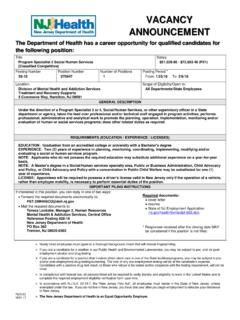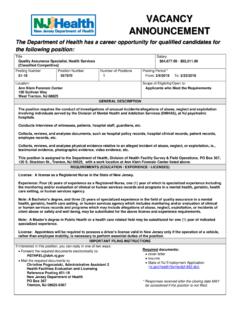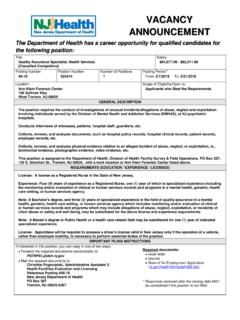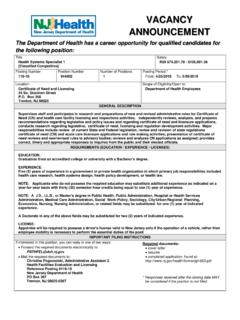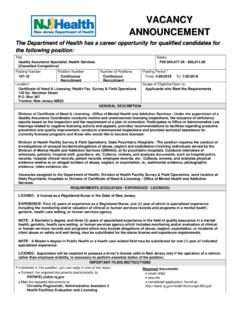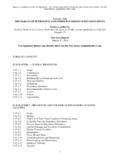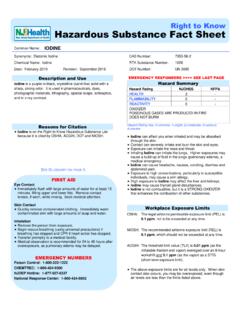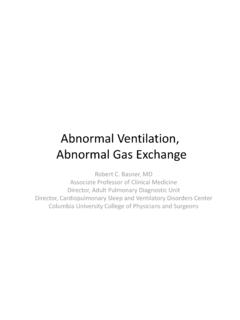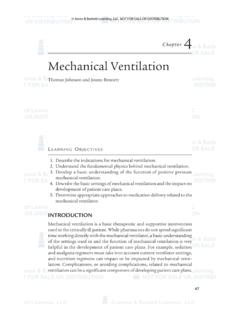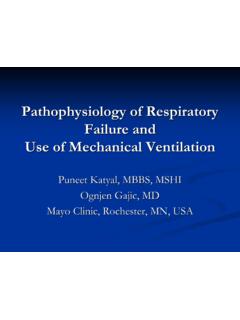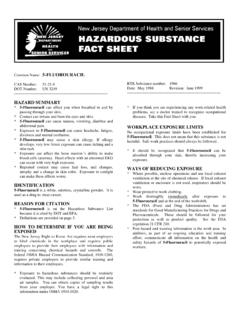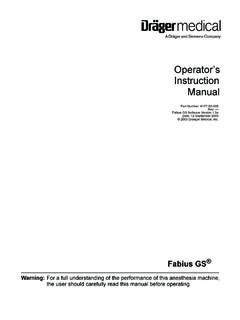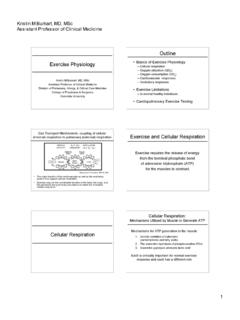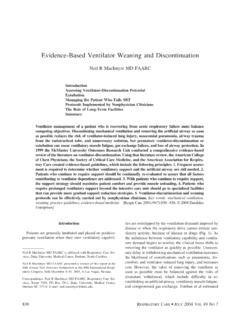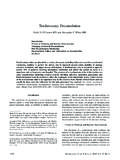Transcription of SODIUM DODECYLBENZENE SULFONATE - New Jersey
1 Common Name: SODIUM DODECYLBENZENE . SULFONATE . CAS Number: 25155-30-0 RTK Substance number: 1698. DOT Number: UN 9146 Date: May 1986 Revision: May 2002. ---------------------------------------- --------------------------------- ---------------------------------------- --------------------------------- HAZARD SUMMARY WORKPLACE EXPOSURE LIMITS. * SODIUM DODECYLBENZENE SULFONATE can affect you when No occupational exposure limits have been established for breathed in. SODIUM DODECYLBENZENE SULFONATE . This does not mean that * Contact can irritate the skin and eyes with possible eye this substance is not harmful. Safe work practices should damage. always be followed. * Breathing SODIUM DODECYLBENZENE SULFONATE can irritate the nose, throat and lungs causing coughing, wheezing WAYS OF REDUCING EXPOSURE.
2 And/or shortness of breath. * Where possible, enclose operations and use local exhaust ventilation at the site of chemical release. If local exhaust IDENTIFICATION ventilation or enclosure is not used, respirators should be SODIUM DODECYLBENZENE SULFONATE is a white to light yellow worn. sand-like solid. It is used as a detergent, in cleaning products, * Wear protective work clothing. and in pesticides. * Wash thoroughly immediately after exposure to SODIUM DODECYLBENZENE SULFONATE . REASON FOR CITATION * Post hazard and warning information in the work area. In * SODIUM DODECYLBENZENE SULFONATE is on the Hazardous addition, as part of an ongoing education and training Substance List because it is cited by DOT and EPA. effort, communicate all information on the health and * Definitions are provided on page 5.
3 Safety hazards of SODIUM DODECYLBENZENE SULFONATE to potentially exposed workers. HOW TO DETERMINE IF YOU ARE BEING. EXPOSED. The New Jersey Right to Know Act requires most employers to label chemicals in the workplace and requires public employers to provide their employees with information and training concerning chemical hazards and controls. The federal OSHA Hazard Communication Standard, , requires private employers to provide similar training and information to their employees. * Exposure to hazardous substances should be routinely evaluated. This may include collecting personal and area air samples. You can obtain copies of sampling results from your employer. You have a legal right to this information under OSHA * If you think you are experiencing any work-related health problems, see a doctor trained to recognize occupational diseases.
4 Take this Fact Sheet with you. SODIUM DODECYLBENZENE SULFONATE page 2 of 6. This Fact Sheet is a summary source of information of all Mixed Exposures potential and most severe health hazards that may result from * Because smoking can cause heart disease, as well as lung exposure. Duration of exposure, concentration of the substance cancer, emphysema, and other respiratory problems, it may and other factors will affect your susceptibility to any of the worsen respiratory conditions caused by chemical exposure. potential effects described below. Even if you have smoked for a long time, stopping now will ---------------------------------------- ----------------------------------- reduce your risk of developing health problems. HEALTH HAZARD INFORMATION WORKPLACE CONTROLS AND PRACTICES.
5 Acute Health Effects Unless a less toxic chemical can be substituted for a hazardous The following acute (short-term) health effects may occur substance, ENGINEERING CONTROLS are the most immediately or shortly after exposure to effective way of reducing exposure. The best protection is to SODIUM DODECYLBENZENE SULFONATE : enclose operations and/or provide local exhaust ventilation at the site of chemical release. Isolating operations can also * Contact can irritate the skin and eyes with possible eye reduce exposure. Using respirators or protective equipment is damage. less effective than the controls mentioned above, but is * Breathing SODIUM DODECYLBENZENE SULFONATE can irritate sometimes necessary. the nose and throat causing coughing and wheezing.
6 In evaluating the controls present in your workplace, consider: Chronic Health Effects (1) how hazardous the substance is, (2) how much of the The following chronic (long-term) health effects can occur at substance is released into the workplace and (3) whether some time after exposure to SODIUM harmful skin or eye contact could occur. Special controls DODECYLBENZENE SULFONATE and can last for months or years: should be in place for highly toxic chemicals or when significant skin, eye, or breathing exposures are possible. Cancer Hazard * According to the information presently available to the New In addition, the following control is recommended: Jersey Department of Health and Senior Services, SODIUM DODECYLBENZENE SULFONATE has not been tested for * Where possible, automatically transfer SODIUM its ability to cause cancer in animals.
7 DODECYLBENZENE SULFONATE from drums or other storage containers to process containers. Reproductive Hazard * According to the information presently available to the New Good WORK PRACTICES can help to reduce hazardous Jersey Department of Health and Senior Services, exposures. The following work practices are recommended: SODIUM DODECYLBENZENE SULFONATE has not been tested for its ability to affect reproduction. * Workers whose clothing has been contaminated by SODIUM DODECYLBENZENE SULFONATE should change into Other Long-Term Effects clean clothing promptly. * SODIUM DODECYLBENZENE SULFONATE can irritate the lungs. * Do not take contaminated work clothes home. Family Repeated exposure may cause bronchitis to develop with members could be exposed.
8 Cough, phlegm, and/or shortness of breath. * Contaminated work clothes should be laundered by individuals who have been informed of the hazards of MEDICAL exposure to SODIUM DODECYLBENZENE SULFONATE . * Eye wash fountains should be provided in the immediate work area for emergency use. Medical Testing * If there is the possibility of skin exposure, emergency If symptoms develop or overexposure is suspected, the shower facilities should be provided. following are recommended: * On skin contact with SODIUM DODECYLBENZENE SULFONATE , immediately wash or shower to remove the chemical. * Lung function tests * Do not eat, smoke, or drink where SODIUM DODECYLBENZENE SULFONATE is handled, processed, or Any evaluation should include a careful history of past and present symptoms with an exam.
9 Medical tests that look for stored, since the chemical can be swallowed. Wash hands damage already done are not a substitute for controlling carefully before eating, drinking, applying cosmetics, exposure. smoking, or using the toilet. * Use a vacuum or a wet method to reduce dust during clean- Request copies of your medical testing. You have a legal right up. DO NOT DRY SWEEP. to this information under OSHA SODIUM DODECYLBENZENE SULFONATE page 3 of 6. PERSONAL PROTECTIVE EQUIPMENT * Be sure to consider all potential exposures in your workplace. You may need a combination of filters, WORKPLACE CONTROLS ARE BETTER THAN prefilters or cartridges to protect against different forms of a PERSONAL PROTECTIVE EQUIPMENT. However, for chemical (such as vapor and mist) or against a mixture of some jobs (such as outside work, confined space entry, jobs chemicals.)
10 Done only once in a while, or jobs done while workplace * Where the potential for high exposure exists, use a NIOSH. controls are being installed), personal protective equipment approved supplied-air respirator with a full facepiece may be appropriate. operated in a pressure-demand or other positive-pressure mode. For increased protection use in combination with an OSHA requires employers to determine the auxiliary self-contained breathing apparatus operated in a appropriate personal protective equipment for each hazard and pressure-demand or other positive-pressure mode. to train employees on how and when to use protective equipment. QUESTIONS AND ANSWERS. The following recommendations are only guidelines and may not apply to every situation.
